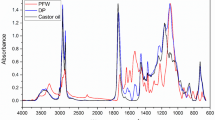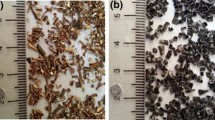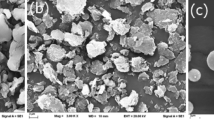Abstract
Ultrafine crushing is a prerequisite for achieving efficient recycling of waste thermoset plastics. In order to address the problems of recycling including low utilization, this research investigates rigid thermoset polyurethane foam insulation board as the research object and selects an integrated dust-free crusher designed independently. The crushing tool adopts the mechanical physical method to break down the plastic. By optimizing the crushing process parameters, combined with the particle size distribution law of the thermosetting plastic recycled material and the discrete element parameter calibration method, a crushing model based on the Hertz–Mindlin (with bonding) theory is designed and carried out. The discrete element method–computational fluid dynamics (DEM–CFD) gas–solid coupling field numerical simulation is used to explore the degradation of the recycled material after the optimization of the mechanical equipment. The results are verified with spectroscopic characterization and response surface method tests. It was found that when the optimized parameters of a five-slice blade, a crushing time of 25 min, and a crusher speed of 5500 rpm are used, the network crosslink density of the waste thermoset plastics is successfully broken. Among the materials tested, the crosslink density of the 120 mesh recycled material is very small (0.00074 mol/cm3). Many renewable polymerized active groups are obtained, and the degradation yield reaches up to 80.34%.


modified from Cho et al. [20])













Similar content being viewed by others
Abbreviations
- BMP:
-
Bonded particle model
- DEM:
-
Discrete element model
- PBM:
-
Population balance model
- BOI:
-
Body of influence
- \({{\varvec{k}}}_{{\varvec{n}}}\) :
-
Normal stress per unit area \(({\text{N}}/{\text{m}}^{3})\)
- \({{\varvec{k}}}_{{\varvec{t}}}\) :
-
Tangential stress per unit area (\(\text{N/}{\text{m}}^{3}\))
- \({{\varvec{\sigma}}}_{{\varvec{c}}}\) :
-
Uniaxial compressive strength (Pa)
- \({{\varvec{\tau}}}_{{\varvec{b}},{\varvec{m}}}\) :
-
Tangential ultimate stress (Pa)
- \({{\varvec{e}}}_{{\varvec{p}}{\varvec{p}}}\) :
-
Coefficient of restitution (particle–particle)
- \({{\varvec{\mu}}}_{{\varvec{p}}{\varvec{p}}}\) :
-
Coefficient of static friction (particle–particle)
- \({{\varvec{\mu}}}_{{\varvec{p}}{\varvec{p}}}^{{\varvec{r}}}\) :
-
Coefficient of rolling friction (particle–particle)
- \({{\varvec{e}}}_{{\varvec{p}}{\varvec{w}}}\) :
-
Coefficient of restitution (particle–wall)
- \({{\varvec{\mu}}}_{{\varvec{p}}{\varvec{w}}}\) :
-
Coefficient of static friction (particle–wall)
- \({{\varvec{\mu}}}_{{\varvec{p}}{\varvec{w}}}^{{\varvec{r}}}\) :
-
Coefficient of rolling friction (particle–wall)
References
Zhong SY (2007) Building plastics. China Petrochemical Press, Hong Kong (in Chinese).
Liu ZC (2007) Design theory and application of material crushing equipment. China University of Mining and Technology, Xuzhou (in Chinese).
Ding L, Cao N, Zhao X (2012) Discussion on physical recycling and cross-linking recycling technology of waste thermosetting plastics. Utilization of Rubber and Plastic Resources 6:28–30 (in Chinese)
Shi L (2013) Research on recycling technology and experiment of waste thermosetting plastics based on mechanical and physical method. Hefei University of Technology, Hefei (in Chinese)
Singh R, Singh I, Kumar R et al (2019) Waste thermosetting polymer and ceramic as reinforcement in thermoplastic matrix for sustainability: thermomechanical investigations. J Thermoplast Compos Mater
Xu YY (2016) Recycling process of waste thermosetting phenolic resin. Hubei University, Wuhan (in Chinese).
Buss AH, Kovaleski JL, Pagani RN et al (2019) Proposal to reuse rubber waste from end-of-life tires using thermosetting resin. Sustainability 11(24):6997
Chen GF (2009) Research on resource utilization technology of waste thermosetting plastics. Donghua University, Shanghai (in Chinese).
Protsenko AE, Pimenova ED, Petrov VV (2020) Recycling of glass fibers sheets from thermoset reinforced plastic using thermolysis method. IOP Conf Ser Mater Sci Eng 734(1): 012185.
João RC, Nuno MA, João RF (2011) Recycling of FRP composites: reusing fine GFRP waste in concrete mixtures. J Clean Prod 19:1745–1753
Pires PGP, Maia AAD, de Paiva JMF (2019) Effect of high pressure laminate residue on the mechanical properties of recycled polypropylene blends. Polym Test 80:106104.
Liu ZF, Shi L, Wu ZW et al (2013) Recycling technology and experimental research of polyurethane foam from waste refrigeration equipment based on mechanical physical method. China Mech Eng 24(06):805–810 (in Chinese)
Barrios GKP, De Carvalho RM, Kwade A et al (2013) Contact parameter estimation for DEM simulation of iron ore pellet handling. Powder Technol 248:84–93
Freireich B, Ketterhagen WR, Wassgren C (2011) Intra-tablet coating variability for several pharmaceutical tablet shapes. Chem Eng Sci 66:2535–2544
Quist J, Evertsson CM (2016) Cone crusher modelling and simulation using DEM. Miner Eng 85:92–105
Potyondy DO, Cundall PA (2004) A bonded-particle model for rock. Int J Rock Mech Min Sci 41(8):1329–1364
Lisjak A, Grasselli G (2014) A review of discrete modeling techniques for fracturing processes in discontinuous rock masses. J Rock Mech Geotech Eng 6(4):301–314
Li YS (2014) Cavity design and optimization of large-scale gyratory crusher. Jilin University (in Chinese)
Sun CL (2000) The latest development of crushers. China Powder Technol 3:35–37 (in Chinese)
Cho N, Martin CD, Sego DC (2007) A clumped particle model for rock. Int J Rock Mech Min Sci 44(7):997–1010.
Groot RD, Stoyanov SD (2011) Close packing density and fracture strength of adsorbed polydisperse particle layers. Soft Matter 7:4750–4761
Zheng GB (2006) Using Rosin Rammler distribution function to study coal dust particle size distribution. J Taiyuan Univ Technol 3:317–319 (in Chinese)
Zhao SY (2006) Accurate calculation of characteristic particle size and uniformity coefficient of RRB distribution model. Nonferrous Min Metall 22:49–52 (in Chinese)
Brouwers HJH (2006) Particle-size distribution and packing fraction of geometric random packings. Phys Rev E 74(3):031309 (in Chinese)
Fang H, Yang J, Song Y et al (2020) Simulation and experimental study on the stone powder separator of a vertical shaft impact crusher. Adv Powder Technol
Vreman B, Geurts BJ, Deen NG et al (2009) Two-and four-way coupled Euler–Lagrangian large-eddy simulation of turbulent particle-laden channel flow. Flow Turbul Combust 82(1):47–71
Del Bello E, Taddeucci J, Vitturi MM et al (2017) Effect of particle volume fraction on the settling velocity of volcanic ash particles: insights from joint experimental and numerical simulations. Sci Rep 7:39620
Fornari W, Zade S, Brandt L et al (2019) Settling of finite-size particles in turbulence at different volume fractions. Acta Mech 230(2):413–430
Wang BH, Jiang L, Hu HB (2019) Experimental study on the influence of wall restriction on swirl flow field. Gas Turb Technol 32(04):1–9 (in Chinese)
Dhakal TP, Walters DK (2009) Curvature and rotation sensitive variants of the K-Omega SST turbulence model. Fluids Eng Div Summer Meet 43727:2221–2229
Solutions DEM (2010) EDEM 2.3 user guide. DEM Solutions, Edinburgh
An EK, Zhang R, Han YF, Liu D (2018) Grid independence analysis of multiphase turbulent combustion numerical simulation. Boiler Technol 49(06):54–58 in Chinese
Chen XX (2012) Rotor design of vertical shaft crusher based on deterministic impact technology. University of Jinan, Jinan (in Chinese).
Zhao J (2012) Flow field analysis and pulverization effect study of thermosetting plastic shearing and crushing. Hefei University of Technology, Hefei (in Chinese).
Shirvan KM, Mamourian M, Mirzakhanlari S et al (2017) Numerical investigation of heat exchanger effectiveness in a double pipe heat exchanger filled with nanofluid: a sensitivity analysis by response surface methodology. Powder Technol 313:99–111
Shechtman O (2013) The coefficient of variation as an index of measurement reliability. Methods of clinical epidemiology. Springer, Berlin, pp 39–49
Acknowledgements
This work was supported by the National Natural Science Foundation of China (Grant Number 51875419).
Author information
Authors and Affiliations
Corresponding author
Ethics declarations
Competing interest
The authors declare that they have no known competing financial interests or personal relationships that could have appeared to influence the work reported in this paper.
Additional information
Publisher's Note
Springer Nature remains neutral with regard to jurisdictional claims in published maps and institutional affiliations.
Rights and permissions
About this article
Cite this article
Fan, Y., Wang, Z. Numerical and experimental research on the degradation mechanism in a dust-free crusher using DEM-CFD method. Comp. Part. Mech. 9, 569–584 (2022). https://doi.org/10.1007/s40571-021-00431-z
Received:
Accepted:
Published:
Issue Date:
DOI: https://doi.org/10.1007/s40571-021-00431-z




